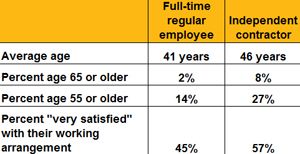
Contingent workers, according to the GAO report include a wide variety of working arrangements (see table).
Citing that “labor experts have not reached consensus on which arrangements represent contingent work,” the GAO report also offers data from other sources. The General Social Survey (GSS), a study conducted by the University of Chicago and released in March 2015 found that just over 16% of the workforce was comprised of independent contractors and self-employed workers. Extrapolating from both the GAO and GSS reports we might surmise that independent contractors alone may account for up to 10% of the U.S. workforce.
The independent contractor group is of particular interest to Talencio, and the GAO report provides some interesting insights about this specific group. Eighty-five percent of independent contractors appear to be content with their employment type, and 57% of independent contractors were “very satisfied” with their job arrangement. This compares to 45% of workers who held standard, full-time employment who indicated that they were “very satisfied” with their employment type.
With regard to fringe benefits, the GAO report found that while fewer contingent workers (in general) rated their fringe benefits as “good,” 61% of independent contractors said their fringe benefits were “good.” Perhaps this reflects an imprecise definition of fringe benefits or the possibility that the workers may perceive flexible work schedule and the ability to choose work engagements to be a fair trade-off for paid vacation and sick days.
Demographically, the GAO report found that independent contractors, in comparison with workers who hold standard full-time jobs.

Now that you’ve taken a closer look at the shifting labor market, to learn more about how other Life Science companies have partnered with us to overcome hurdles and capacity issues, and tapped into our skilled professional talent pool, contact me at 612.703.4236 or email me at: pnorbom@talencio.com. Talencio, LLC has been the preferred provider of vetted, accomplished professionals to the Life Sciences community for more than seven years.
Sources:
New Data Spotlights Changes in the U.S. Workforce. Wall Street Journal, May 28, 2015.